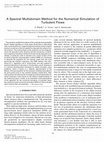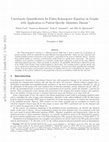Papers by Alfio Quarteroni
Springer eBooks, 2014
Quest'opera è protetta dalla legge sul diritto d'autore e la sua riproduzione è ammessa solo ed e... more Quest'opera è protetta dalla legge sul diritto d'autore e la sua riproduzione è ammessa solo ed esclusivamente nei limiti stabiliti dalla stessa. Le fotocopie per uso personale possono essere effettuate nei limiti del 15% di ciascun volume dietro pagamento alla SIAE del compenso previsto dall'art. 68. Le riproduzioni per uso non personale e/o oltre il limite del 15% potranno avvenire solo a seguito di specifica autorizzazione rilasciata da AIDRO,

The numerical solution of partial differential equations (PDEs) depending on parametrized or rand... more The numerical solution of partial differential equations (PDEs) depending on parametrized or random input data is computationally intensive. Reduced order modeling techniques, such as the reduced basis methods, have been developed to alleviate this computational burden, and are nowadays exploited to accelerate real-time analysis, as well as the solution of PDE-constrained optimization and inverse problems. These methods are built upon low-dimensional spaces obtained by selecting a set of snapshots from a parametrically induced manifold. However, for these techniques to be effective, both parameter-dependent and random input data must be expressed in a convenient form. To address the former case, the empirical interpolation method has been developed. In the latter case, a spectral approximation of stochastic fields is often generated by means of a Karhunen-Loève expansion. In all these cases, a low dimensional space to represent the function being approximated (PDE solution, parametrized data, stochastic field) can be obtained through proper orthogonal decomposition. Here, we review possible ways to exploit this methodology in these three contexts, we recall its optimality properties, and highlight the common mathematical structure beneath. * This is the way POD is called in the context of stochastic processes. In multivariate statistics, instead, POD goes under the name of principal component analysis, where the POD modes are called principal components.
Numerical Models for Differential Problems, 2014
ABSTRACT
Lecture Notes in Mathematics, 2012
Mathematical models of complex physical problems can be based on heterogeneous differential equat... more Mathematical models of complex physical problems can be based on heterogeneous differential equations, i.e. on boundary-value problems of different kind in different subregions of the computational domain. In this presentation we will introduce a few representative examples, we will illustrate the way the coupling conditions between the different models can be devised, then we will address several solution algorithms and discuss their properties of convergence as well as their robustness with respect to the variation of the physical parameters that characterize the submodels.
MS&A, 2012
The use of general descriptive names, registered names, trademarks, etc. in this publication does... more The use of general descriptive names, registered names, trademarks, etc. in this publication does not imply, even in the absence of a specific statement, that such names are exempt from the relevant protective laws and regulations and therefore free for general use.
SeMA Journal, 2011
In this work, we propose an hN adaptive algorithm for optimal control problems whose space discre... more In this work, we propose an hN adaptive algorithm for optimal control problems whose space discretization is based on the spectral element method. We focus on a special class of problems described by quadratic cost functional and linear advection-diffusion state equation. This model has been employed to forecast and suitably reduce, by an optimization process, the pollutant concentration in air on a specific area of interest. Moreover, a local adaptive algorithm is employed to achieve a desired accuracy on the cost functional by reducing the computational cost of the problem.

Journal of Computational Physics, 1997
come several intrinsic limitations of spectral methods, allowing for the use of the latter in a w... more come several intrinsic limitations of spectral methods, allowing for the use of the latter in a wider context [5-8]. The primitive variable formulation of the unsteady incompressible Navier-Stokes equations in three space dimensions is discretized The most obvious application of spectral multidomain with a combined Fourier-Legendre spectral method. A semi-implicit methods is related to the solution of partial differential pressure correction scheme is applied to decouple the velocity from equations over complex geometries (i.e., geometries which the pressure. The arising elliptic scalar problems are first diagonalcannot be trivially mapped in the standard [Ϫ1, 1] square). ized in the periodic Fourier direction and then solved by a multido-Another important feature of this class of algorithms is main Legendre collocation method in the two remaining space coordinates. In particular, both an iterative and a direct version of the the natural way in which they exploit the architectures of so-called projection decomposition method (PDM) are introduced modern MIMD computers (including clusters of workto separate the equations for the internal nodes from the ones stations) paving the way for large scale simulations othergoverning the interface unknowns. The PDM method, first introwise accessible only to supercomputer users. In fact, the duced by V. Agoshkov and E. Ovtchinnikov and later applied to spectral methods by P. Gervasio, E. Ovtchinnikov, and A. Quarteroni parallelization efficiency is extremely favourable to specis a domain decomposition technique for elliptic boundary value tral multidomain methods: the ratio of computation time problems, which is based on a Galerkin approximation of the to communication time is larger for this family of methods Steklov-Poincaré equation for the unknown variables associated to than for others. This is mainly due to the high order accuthe grid points lying on the interface between subdomains. After racy provided by the spectral method combined with the having shown the exponential convergence of the proposed discretization technique, some issues on the efficient implementation of fact that the discrete operators involve matrices not as the method are given. Finally, as an illustration of the potentialities sparse as other ''local'' methods (i.e., finite differences, of the algorithm for the numerical simulation of turbulent flows, finite element or finite volumes) [9]. the results of a direct numerical simulation (DNS) of a fully turbulent The present Navier-Stokes solution algorithm differs plane channel flow are presented.
Note: Vol. 6 Reference LIN-CONF-2004-001 Record created on 2007-05-22, modified on 2016-08-08

ABSTRACT A three-dimensional (3D) finite element method is proposed for shallow-water equations (... more ABSTRACT A three-dimensional (3D) finite element method is proposed for shallow-water equations (SWE). The method is based on the Raviart-Thomas finite element approximation. A numerical solution for shallow-water flows is developed based on the unsteady Reynolds-averaged Navier-Stokes (RANS) equations. In this work the assumption of hydrostatic pressure is applied. The SWE equations are solved in a given multilayered system (which consists of an a priori subdivision of the vertical direction of the domain into layers of fixed thickness), with a semi-implicit time stepping method. The eddy viscosity is calculated usind the standard k-epsilon turbulence model. The boundary conditions at the bed are based on the equilibrium assumption of the production terms with vertical diffusion terms using wall functions. To test the validity of the new algorithm the model is applied to three-dimensional flows for which experimental data and other numerical results are available for comparison.

International Journal for Numerical Methods in Biomedical Engineering
Reducing the computational time required by high‐fidelity, full‐order models (FOMs) for the solut... more Reducing the computational time required by high‐fidelity, full‐order models (FOMs) for the solution of problems in cardiac mechanics is crucial to allow the translation of patient‐specific simulations into clinical practice. Indeed, while FOMs, such as those based on the finite element method, provide valuable information on the cardiac mechanical function, accurate numerical results can be obtained at the price of very fine spatio‐temporal discretizations. As a matter of fact, simulating even just a few heartbeats can require up to hours of wall time on high‐performance computing architectures. In addition, cardiac models usually depend on a set of input parameters that are calibrated in order to explore multiple virtual scenarios. To compute reliable solutions at a greatly reduced computational cost, we rely on a reduced basis method empowered with a new deep learning‐based operator approximation, which we refer to as Deep‐HyROMnet technique. Our strategy combines a projection‐ba...

arXiv (Cornell University), May 5, 2023
The Fisher-Kolmogorov equation is a diffusion-reaction PDE that is used to model the accumulation... more The Fisher-Kolmogorov equation is a diffusion-reaction PDE that is used to model the accumulation of prionic proteins, which are responsible for many different neurological disorders. Likely, the most important and studied misfolded protein in literature is the Amyloid-β, responsible for the onset of Alzheimer disease. Starting from medical images we construct a reduced-order model based on a graph brain connectome. The reaction coefficient of the proteins is modelled as a stochastic random field, taking into account all the many different underlying physical processes, which can hardly be measured. Its probability distribution is inferred by means of the Monte Carlo Markov Chain method applied to clinical data. The resulting model is patient-specific and can be employed for predicting the disease's future development. Forward uncertainty quantification techniques (Monte Carlo and sparse grid stochastic collocation) are applied with the aim of quantifying the impact of the variability of the reaction coefficient on the progression of protein accumulation within the next 20 years.
Numerische Mathematik, Jun 24, 2011
In the present work a general theoretical framework for coupled dimensionally-heterogeneous parti... more In the present work a general theoretical framework for coupled dimensionally-heterogeneous partial differential equations is developed. This is done by recasting the variational formulation in terms of coupling interface variables. In such a general setting we analyze existence and uniqueness of solutions for both the continuous problem and its finite dimensional approximation. This approach also allows the development of different iterative substructuring solution methodologies involving The first author acknowledges the support of the Brazilian agencies CNPq and FAPERJ. The second and third authors acknowledge the European Research Council Advanced Grant "Mathcard, Mathematical Modelling and Simulation of the Cardiovascular System", Project ERC-2008-AdG 227058.
Mathematical Modelling and Numerical Analysis, Apr 8, 2015
In this paper we present a new reduced basis technique for parametrized nonlinear scalar conserva... more In this paper we present a new reduced basis technique for parametrized nonlinear scalar conservation laws in presence of shocks. The essential ingredients are an efficient algorithm to approximate the shock curve, a procedure to detect the smooth components of the solution at the two sides of the shock, and a suitable interpolation strategy to reconstruct such smooth components during the online stage. The approach we propose is based on some theoretical properties of the solution to the problem. Some numerical examples prove the effectiveness of the proposed strategy.








Uploads
Papers by Alfio Quarteroni